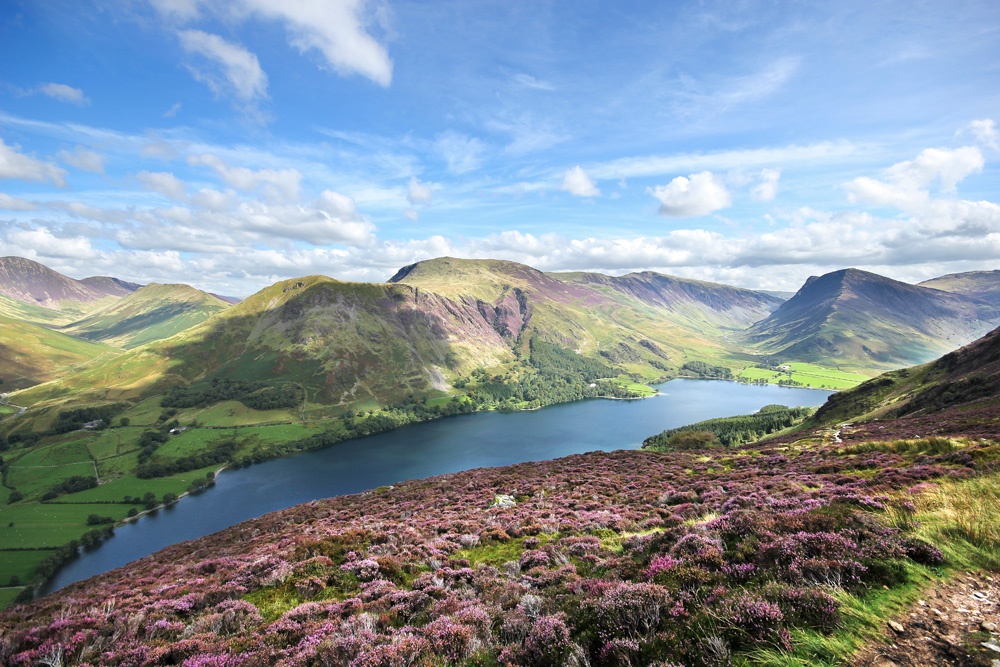
Buttermere - Image by PicturesOfEngland.com member John Godley (view gallery)
This list contains some of the most famous and highly recognisable views in the whole of England, from the dramatic view of Bamburgh Castle in the north, to the awe-inspiring view of Durdle Door along the incredible Jurassic Coastline World Heritage Site in the south, these views are some of the finest to be seen anywhere in the world. Yet it is not just all about the view, for each one has an incredible history behind it, which, once you are aware of it, simply adds to the beauty of what you see. We hope you enjoy these incredible glimpses of the immense beauty of England.
Each list item contains links to more pictures and more information to help you discover as much as possible about these incredible places.
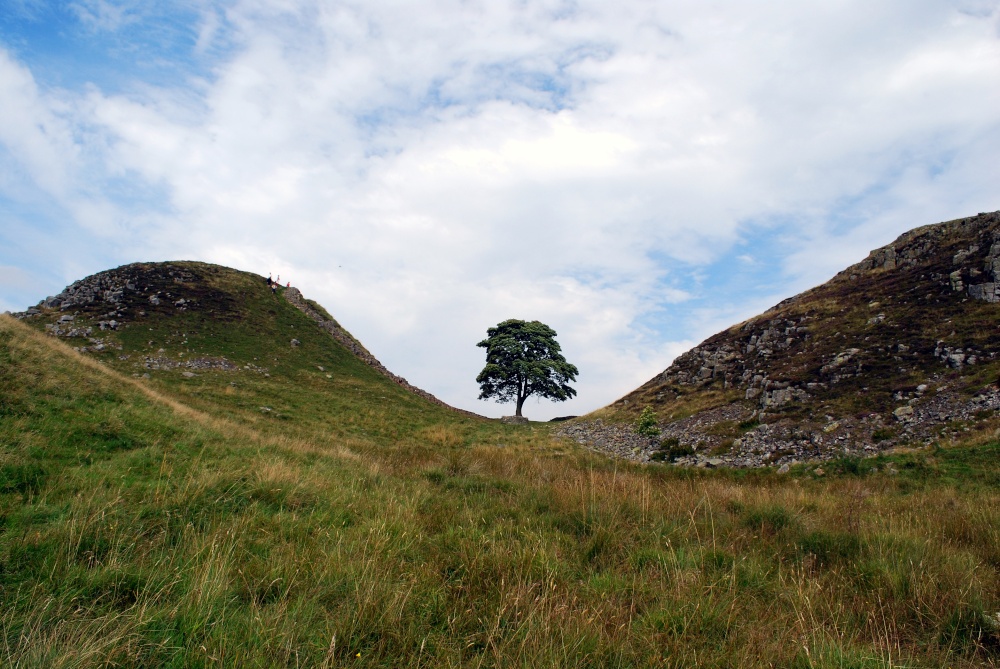
Hadrians Wall - Image by PicturesOfEngland.com member Ray Hutcheon (view gallery)
Sycamore Gap is a famous landmark along Hadrian's Wall - a famous wall in the north of England built by the Romans. The gap is a dip in the landscape caused by melting glacial waters underneath the sheet ice that once covered the area thousands of years ago.
The location was made famous by the film Robin Hood: Prince of Thieves (1991) starring Kevin Costner. It was also featured in the video to the popular theme song from the film, a song which was a huge hit for Bryan Adams. The Sycamore is often referred to as 'The Robin Hood tree' because of these associations.
The tree, which is several hundred years old, was entered into the 'England's Tree of the Year' competition and saw off 200 other trees to win the £1000 prize which goes towards its preservation.
The tree is also one of the most photographed trees in England.
ID#3511
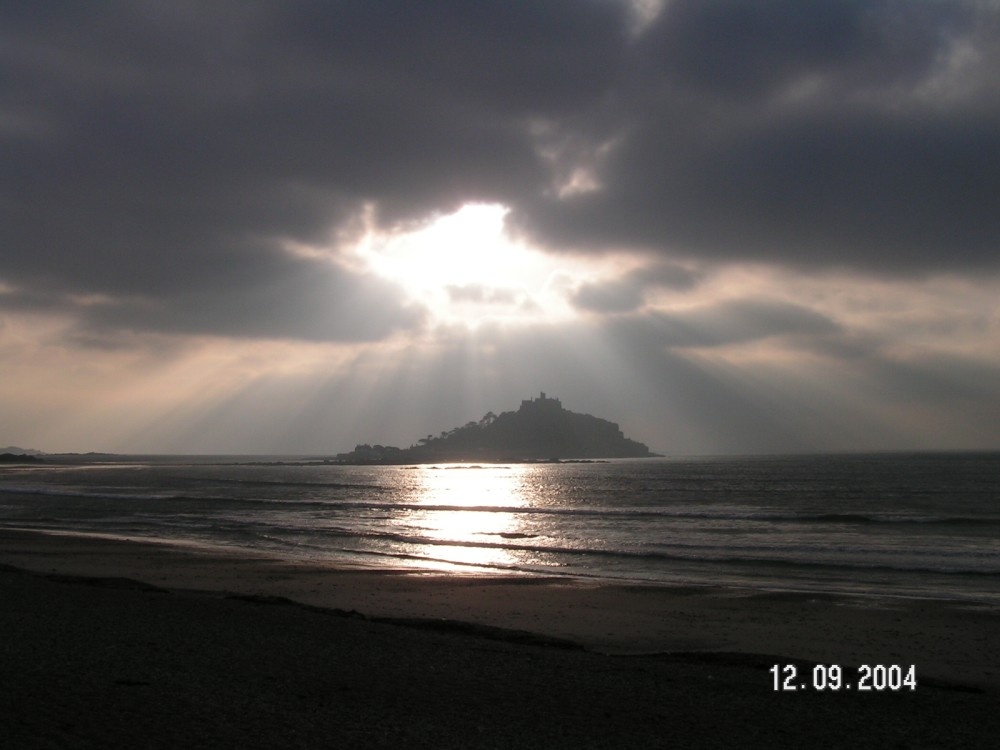
St. Michaels Mount, Cornwall, taken on a beautiful September morning - Image by PicturesOfEngland.com member Craig Ballantyne (view gallery)
The priory on St.Michael's mount is dedicated to the Archangel who is believed to have appeared to local fishermen in AD 495. The mount is a spectacular focal point from the beaches of Mount's Bay and can be reached on foot via a causeway from Marazion, or when the tide cuts the passage off, a ferry plies visitors back and forth to the island.
A Benedictine monastery was established here in the 12th-century this was a sister monastery of Mont St. Michael in Brittany, France. Following the dissolution of the monasteries, the priory was left empty. After the restoration it became the home of the St.Aubyn family, who remained in occupation from 1679 until they gifted the island to the National Trust in 1954.
To this day there are those who, on visiting the island feel the pull of its religious connections, and thus it is still regarded by many people as a place of pilgrimage. This is not surprising as one of the rooms on show in the castle was formerly the monk's refectory, it is decorated with a 17th-century frieze round the walls, handsome furniture and portraits. In the Blue Drawing Room you can see fine Chippendale furniture and superb Gothic plasterwork. As the name suggests, in the Map room there are displays of original maps, silver, tapestries and cloths. The many magnificent paintings include works by Gainsborough, Hudson and Kneller.
Interestingly, another legend exists connecting the Mount to St Keyne, who is said to have blessed a stone seat here with the power to grant dominance in marriage to which-ever partner managed to sit on the seat first!
From the island you can enjoy breathtaking views of the seemingly endless white tipped waves of the silvery sea, and glorious views of the sands and cliffs of the mainland.
ID#97
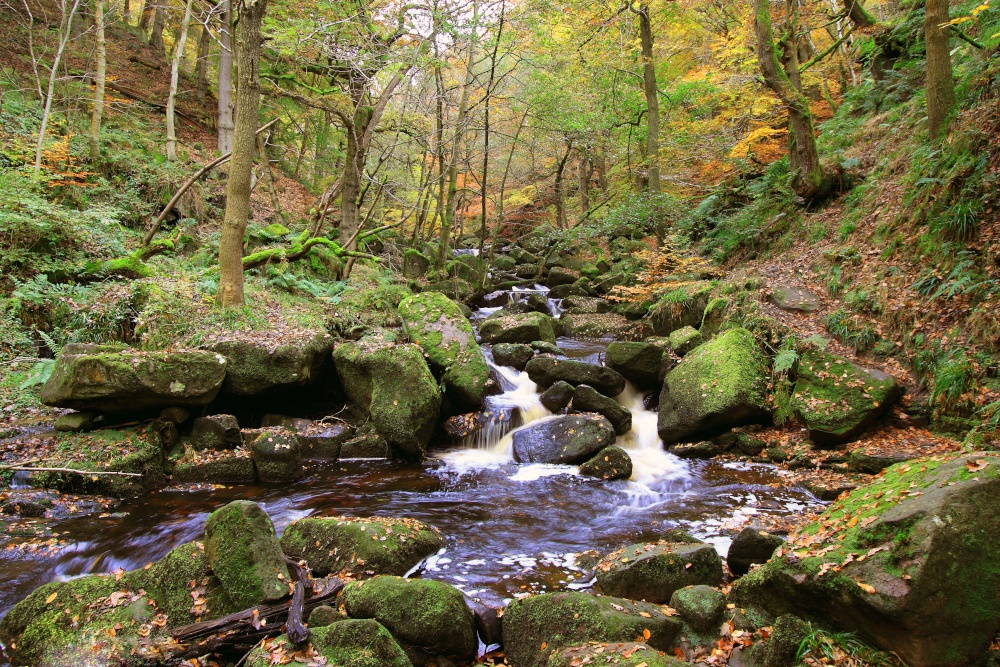
Padley Gorge - Image by PicturesOfEngland.com member James Carter (view gallery)
Padley Gorge is a popular tourist spot in the Peak District, with streams and waterfalls all in a beautiful woodland setting. Nearby can be found the beautiful National Trust Longshaw Estate.
ID#5588
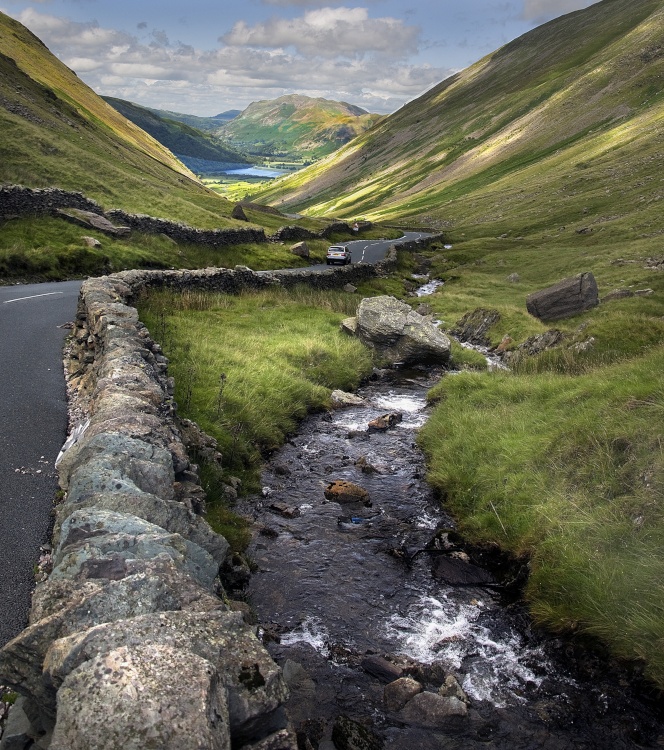
Kirkstone Pass - Image by PicturesOfEngland.com member Rod Burkey (view gallery)
As one of the most scenic regions of England, The Lake District in the county of Cumbria has many spectacular views which we shall cover in a separate article, however, the Kirkstone pass, being the Lake District's highest pass open to motor vehicles, offers an incredible view along the winding valley towards Ullswater, and as such has become one of the most photographed places in England. The pass connects Ambleside to Patterdale in the Ullswater Valley, with Brothers water being the lake that sits in the distance. There is an Inn at the summit of the pass, The Kirkstone Inn, which is the third-highest public house in England and was once an important coaching inn but now caters for mainly tourists visiting the area. On a fine day you can sit out in the pub garden and enjoy the spectacular views, and maybe grab a photograph or two of one of the best and most dramatic views to be found in beautiful England.
ID#10799
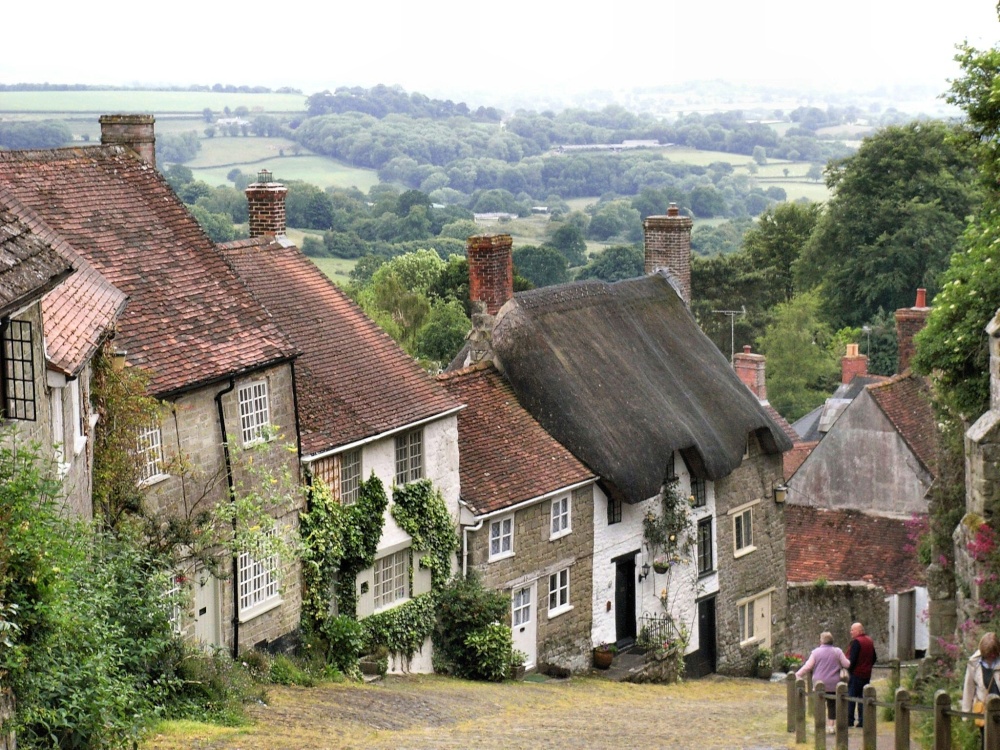
Gold Hill, Shaftesbury - Image by PicturesOfEngland.com member Peggy Cannell (view gallery)
This beautiful view looking down and across the cobbled street of Gold Hill in the town of Shaftesbury is one of the most famous views in England, appearing on the covers of many books, magazines, calendars, and making several appearences on television, most notably in the famous 1973 Hovis bread advert, which in 2006 was voted Britain's favourite advert of all time. The advert features a boy pushing his bike up the cobbles of Gold Hill, with a laden basket of bread on the front of his bike. The advert contains Antonin Dvorak's Symphony No. 9, in Brass, which in England has become synonomous with the advert itself and the iconic location. The advert was directed by famous English filmmaker Sir Ridley Scott, of Alien, Bladerunner, and Galdiator fame.
Shaftesbury is well worth a visit, not just for the stunning view from Gold Hill but it has a rich and interesting history going back to Saxon times, and features some fascinating buildings, including the remains of Shaftesbury Abbey which was founded by King Alfred the Great around 888 and became one of the richest religious establishments in England before it was destroyed in 1539 during the Dissolution.
Use the links below to see more pictures and learn more history and facts about the town of Shaftesbury. You can also check out the famous Hovis bread advert on our Shaftesbury videos page, along with other videos of the town.
ID#30894
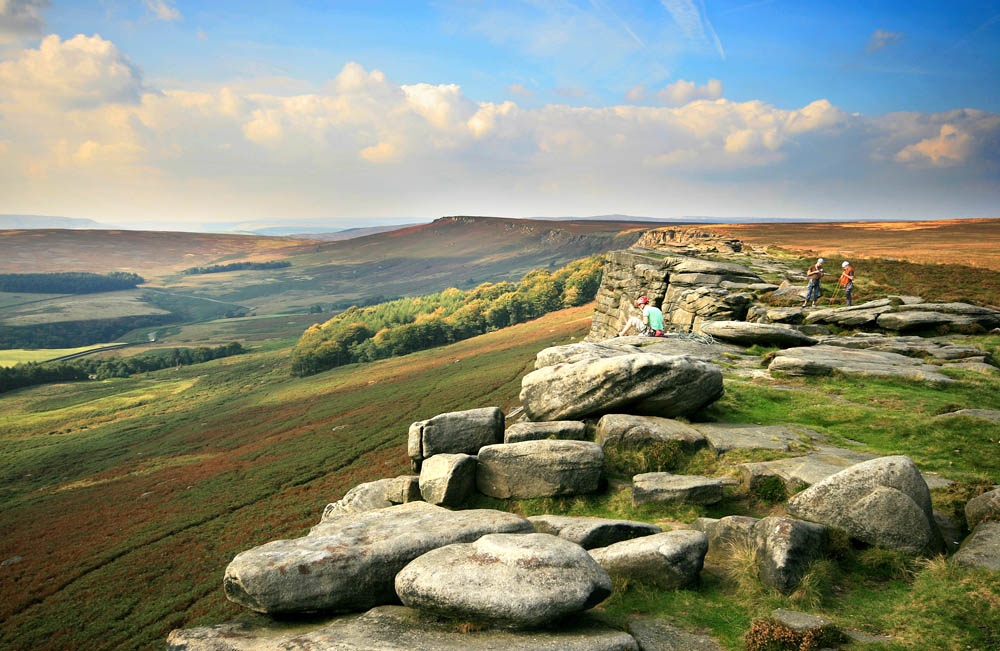
Rock Climbers on Stanage Edge - Image by PicturesOfEngland.com member John Godley (view gallery)
Stanage Edge is an elevated gritstone edge or enscarpment that stretches for around 4 miles giving extensive views across the Peak District's Hope Valley, the Dark Peak moorlands, and beyond. Indeed, it is said that on a clear day you can even see the Malvern Hills, which are 60 miles away or more, but it is the nearer views of the peaks and windswept moors that people come to see, and that have been such an inspirtation for many, including the famous Charlotte Bronte who's novel Jane Eyre features many places that match locations around the area, such as North Lees Hall ("Thornfield Hall") on the outskirts of the nearby historic village of Hathersage.
The highest point of Stanage Edge is the High Neb, which is 1,503ft above sea level, and the edge is extremely popular with walkers, runners and particularly climbers who come to experience one of Britain's most popular climbing spots and take in the incredible views.
There was once a paved packhorse trail along the top of the edge, with parts still remaining today, and descending the edge is what is known as the 'Long Causeway' - a medieval packhorse route that ran between Sheffield in South Yorkshire, and Hathersage in Derbyshire. The route was used by traders to bring salt to Yorkshire from the Cheshire Salt Mines during the Middle Ages, and later during the 18th century, carts would carry other goods including barrels of tar, treacle, oil, lead and grinding stones.
The Edge itself was once quarried for large grinding stones known as millstones, and the remnants of this era can still be seen today with large discarded millstones strewn around the edge in places such as at High Neb where they have become an indelible part of the landscape and are often used as a symbol of the Peak District itself.
More recently, Stanage Edge was featured in the 2005 remake of the classic 'Pride & Prejudice' starring Keira Knightly, and many people seek out the exact spot where she stood in the film, which is now known as 'Keira Knightly Rock'.
ID#5483
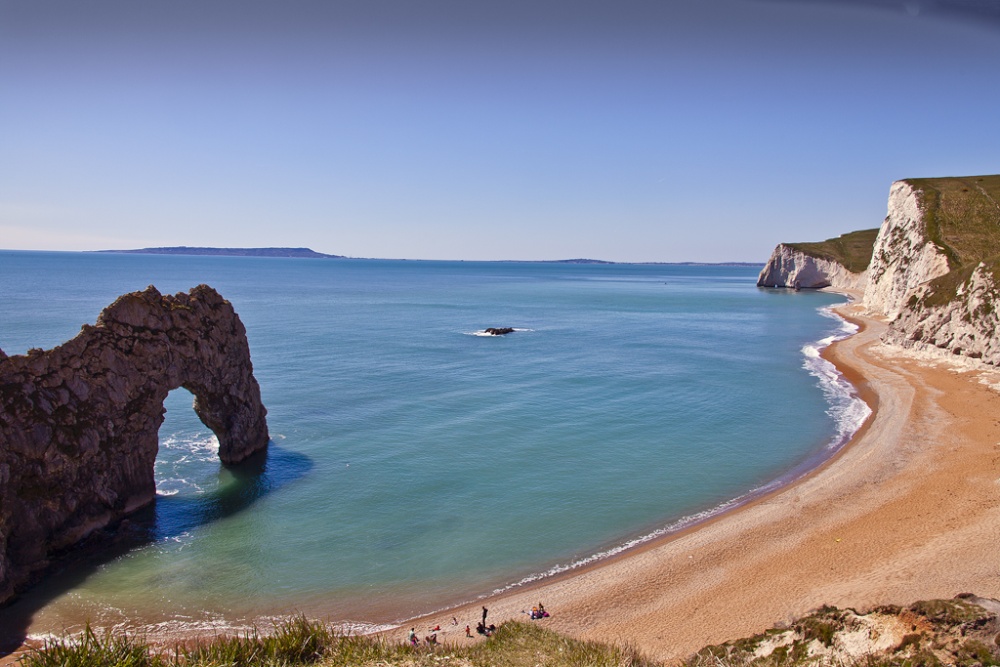
Durdle Door, Dorset - Image by PicturesOfEngland.com member Paul Hilton (view gallery)
On a coast of fabulous high white cliffs there are few views to rival the spectacular Durdle Door. This natural phenomena, carved by the sea must rank as one of the most photographed scenes on the Jurassic Coast, it is certainly one of the coastal wonders of Britain.
It is a beautiful place, a shingle cove surrounded by rocks where a 'door' has been formed by the sea eating away at relatively soft rock, leaving an exquisite open arch of hard Portland stone. Crystal clear waters flow through the door, sweeping softly up the pretty sloping beach which is used for bathing and this, together with other little coves make it a pleasurable place for sub-aqua enthusiasts.
Lying a short distance from famed Lulworth Cove where fascinating arms of rock enfold pools of water left by a retreating tide, make this a picturesque and exciting place to explore. Lulworth has delightful thatched cottages, pleasant shops and friendly inns and quaint shops, and cafe's. At nearby Bat's Head, a smaller arch carved by waves can be seen - this is affectionately known as the 'mousehole' it is beneath massive rock formations jutting out into the sea. From the mossy headland above there are seascapes of incomparable splendour.
Places to visit include: Bowleaze Cove, Kimmeridge Bay, Swanage Railway, Corfe Castle (NT) and Wareham - pretty market town.
ID#26
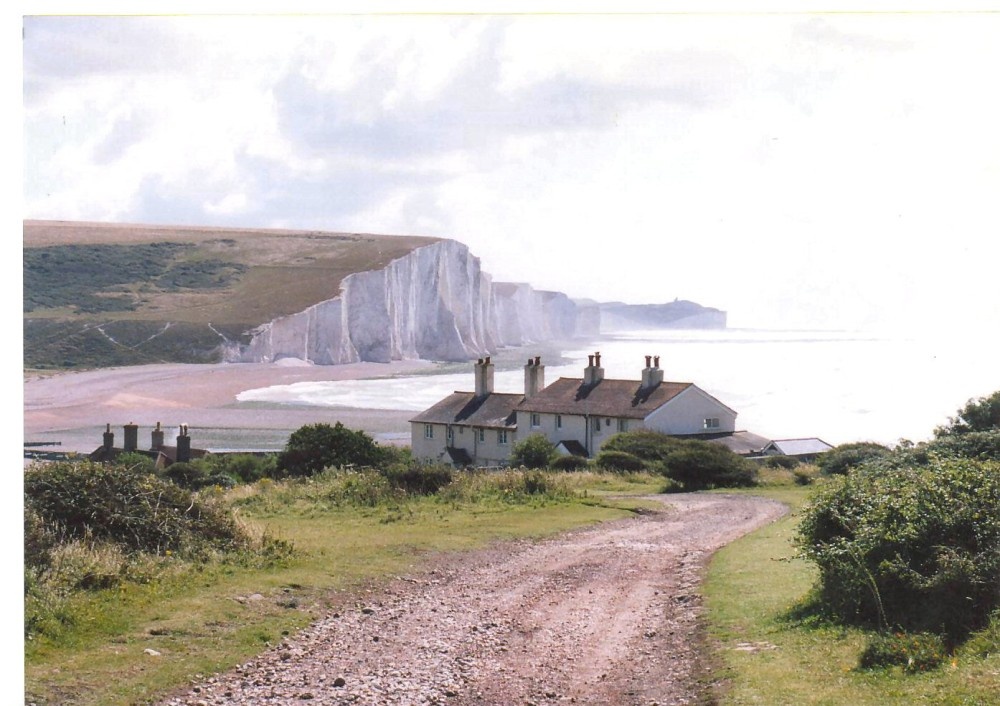
Seven Sisters, East Sussex - Image by PicturesOfEngland.com member Mick Carver (view gallery)
Designated a site of Special Scientific Interest, in an Area of Outstanding Natural Beauty (AONB), the Seven Sisters Country Park is part of one of Britain's finest unspoilt coastlines, the Sussex Heritage Coast. The country park itself covers approx 700 acres (280 hectares) being made up of chalk cliffs, open chalk meadows, woodlands and meandering river valley. Great for activities such as walking, cycling, canoeing, birdwatching or simply having a picnic and taking in the stunning surroundings. Also in the area are a number of 18th century flint barns, one housing the tourist information centre, another is The Living Museum.
ID#9803
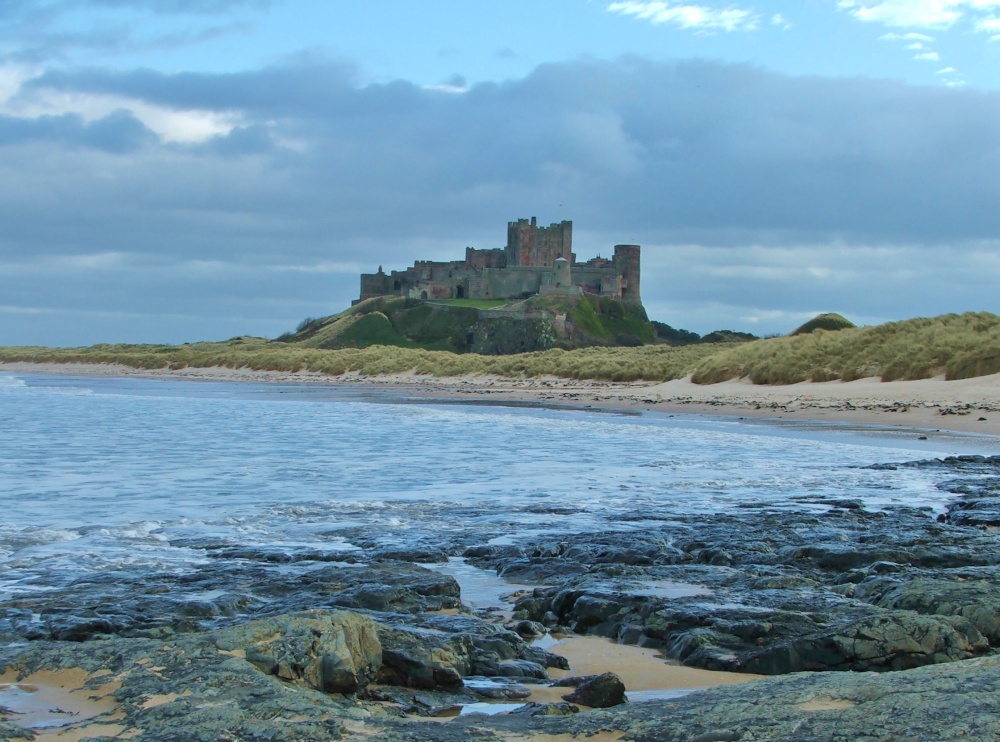
Castle - Image by PicturesOfEngland.com member Graham John Willetts (view gallery)
Bamburgh's huge Norman castle was once the seat of the Kings of Northumbria. It is set on a Basalt outcrop overlooking the limitless beauty of the North Sea coastline with far reaching views of the Farne Islands and Holy Island.
The castle has a turbulent history, during the War of the Roses it was a Lancastrian stronghold, and it was to Bamburgh that Henry VI and his wife Queen Margaret of Anjou fled, following the Battle of Hexham when they were defeated by the Yorkists.
Bamburgh Castle is in private ownership, it is the home of the Armstrong family. The glittering castle we see today is due to the tireless work of the Ist Lord Armstrong, wealthy industrialist, who began the restoration of Bamburgh in 1890. The late Lord Armstrong continued with his ancestors inspirational work and saw his dream through to fruition. It is now one of the most beautiful and best preserved castles in England. The rich interior and magnificent collections on display are matched only by the castle's idyllic location.
All the rooms on view contain fine furniture, tapestries, paintings, exquisite porcelain and in the Armoury, you can see Arms and Armour dating from the 15th to the 19th century including pikes and muskets issued to the militia at the time of the Napoleonic Wars. Rooms open to public view include a series of reception rooms, the magnificent King's Hall, the Cross Hall, the Bakehouse, the Victorian Scullery and Dungeons. The Ist Lord Armstrong was an engineer, inventor and industrialist. His memory is honoured by a museum dedicated to his life and times which is sited in what was once the Laundry.
Bamburgh Castle is open from April to October, it is a place of historic charm and exceptional beauty which is well worth a visit.
ID#102
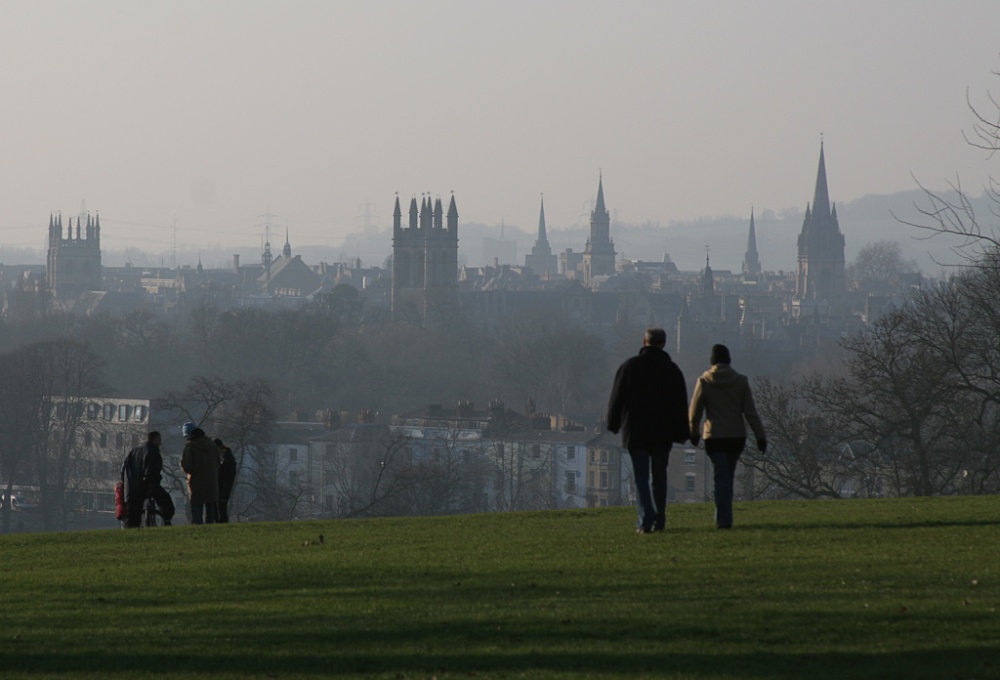
Oxford in November - Image by PicturesOfEngland.com member Allan Rostron (view gallery)
Oxford's fame is perhaps second only to Windsor, it is an acclaimed seat of learning with a University whose first college was founded in 1249, almost half a century after the first charter granted to the town by Henry II. Since this time Oxford has had its share of historic events, one of the earliest being the "Mad Parliament" of Henry III held in Oxford in 1258.
The city is fortunate in its beautiful riverside position at the confluence of the River Cherwell and Thames, this gives the opportunity for visitors to enjoy such pleasant pursuits as boating and punting, or to enjoy a stroll along river banks to see the natural life of the waters.
It is the college buildings that form the real "heart" of Oxford; these were mostly founded during the 13th and 14th centuries, Balliol was established in 1263 followed by Merton in 1264 and by the time Queen's college was completed in 1340 Oxford University was a fully established rival to the University of Paris and other continental cities. It is these magnificent buildings together with St Edmund's Hall, Exeter, Oriel and Oxford's churches that have caused Oxford to be known as a city of "Dreaming Spires" and deservedly so for looking across the city from the high vantage point of Boar's Hill one is immediately struck by the immense beauty of Oxford. Another place which gives a remarkable view of the city is the 14th century Carfax Tower, from here the panoramic view is a handsome reward for climbing the towers 99 steps!
The church of St.Mary the Virgin is Oxford's most famous University church, this is mainly of the 15th century but has a 13th century tower and a magnificent ornate 14th century spire. A baroque south porch was added to the church in the middle of the 17th century, this was designed by Nicholas Stone, it is admired for its fine "Barley Sugar" columns and outstanding statue of the Virgin and Child placed above the entrance. The fact that this church was mentioned in the Doomsday Book indicates the possibility of an earlier church on the same spot.
St.Michael's parish church possess a pre-Norman tower dating from early 11th century, although this church has been altered and added to over several centuries, today it stands almost exactly as it was in the 15th century. The tower is the oldest remaining 11th century building in Oxford.
Interestingly Oxford has England's oldest public museum, this is the Ashmolean Museum, its first buildings were opened in 1683, and the present buildings were built in 1845 to a design by Charles Cockerell. The museum houses outstanding collections of paintings, glass, porcelain, silver and artefacts from the great civilisations of the Mediterranean, Eastern countries and the Orient. This museum also houses the University's fine collection of ancient Egyptian relics. Visitors to the city may also visit Oxford University Museum of Natural History, The Museum of Modern Art, The Bate Collection, The Pitt Rivers Museum and the Museum of Oxford.
Defining the centre of Oxford is the rotunda building known as The Radcliffe Camera, this was designed by James Gibb in the middle of the 18th century. This is a beautiful building thought to have been modelled on The Tower of the Winds in Athens. It is not open to the public, but the 16 sided ground floor room is used as a reading room for the Bodleian Library.
Of great interest are the stunningly beautiful University Botanic Gardens, these are found opposite Magdalen College in Rose Lane. They were originally laid out at the instruction of the Earl of Danby as a Physic Garden during the early part of the 17th century. In their lovely riverside setting these are the oldest established Botanic Gardens in England, and are a triumph of rare trees, flowers and precious plants from all around the world.
Visiting Oxford today you can enjoy the celebration of its historic past whilst part-taking of its modern offerings, these can be found in streets full of tempting shops, a Victorian covered market, multi-cultural restaurants and a diverse range of entertainments. There is an interesting University shop and several shops selling antiques, painting, prints and old maps of the city. Drama and comedy are offered in the city's theatres and often the Apollo Theatre presents shows direct from the west end of London. For music and dance you can do no better than check out the programme for the Georgian Theatre. For anyone interested in the life of C S Lewis, why not take the C S Lewis Tour for a truly unique and memorable experience, tours can be booked at www.cslewistours.com. With all of this plus two beautiful rivers to glide along to enjoy the sights and sounds of nature, Oxford makes an interesting destination for a romantic weekend, or for a longer stay to absorb everything this fine historic city has to offer.
ID#62

Buttermere - Image by PicturesOfEngland.com member John Godley (view gallery)
The Lake District is a photographers dream, with stunning views in every direction, no matter what the weather, and as said before, the Lake District is worthy of its own list of best views as there are so many to choose from. For this article however, we have chosen to feature (along with Kirkstone pass) the beautiful Buttermere lake, for there are several memorable viewpoints that are famous, and one in particular was immortalised by the Romantic painter J.M.W.Turner in his painting from 1797 'Crummock Water Looking Towards Buttermere' which showed just a glimpse of Buttermere but captured the drama and beauty of the whole valley itself, with its neighbouring Crummock Water which was once part of the same lake many millenia ago.
ID#8604
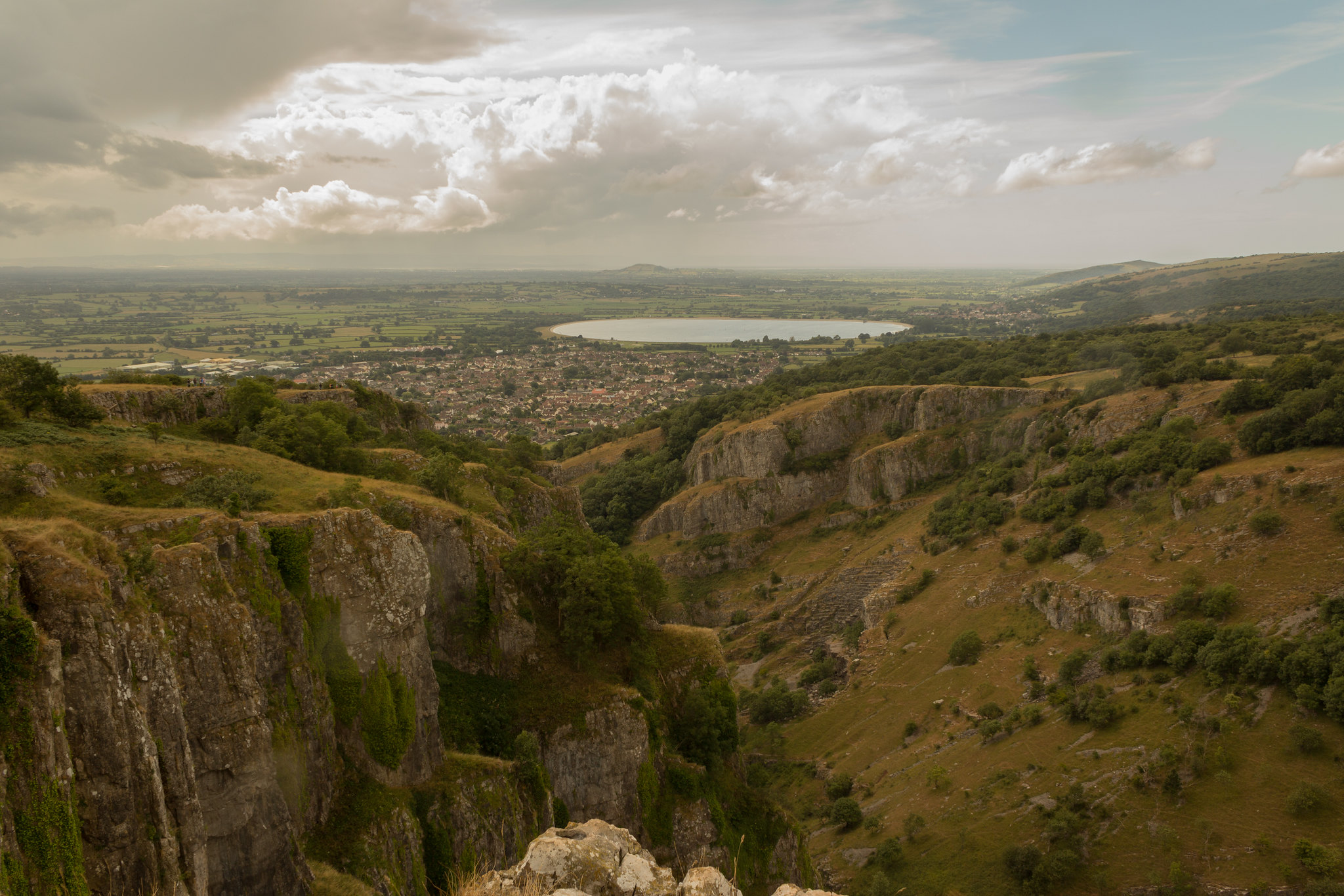
Cheddar Gorge - Image Credit: Anup Shah @ Flickr License: CC BY-SA 2.0
The mile or so of pale-grey limestone cliffs rising above the winding road through Cheddar is awesome in its untamed beauty, it appears wild and exciting, far removed from the village which these days exists on pure commercialism. The road leads through to the beautiful Mendip Hills, these have many remote areas and present a sparsely populated landscape dotted with just a few farms, and the occasional inn used by "cavers" locals and tourists. The views all around are quite dramatic, especially when the mist creeps over, mist rises quickly in these parts and it is not unknown for walkers, or climbers to loose their bearings.
The most spectacular views of the Somerset countryside are to be enjoyed on a clear summers day from the top of the cliffs, easily reached by "Jacob's Ladder" at the northern end of Cheddar. Cheddar boasts England's highest inland cliffs, these provide a nesting place for Peregrine Falcons.
These days the town is dominated by its famous show caves, Cox's and Gough's, both contain fine stalagmites and stalactites. Gough's cave is the largest of the caves, it was discovered in 1890 by sea captain Richard Gough, for whom it is named. This leads to the Diamond Chamber and Solomon's Temple. A thrilling exhibition explains the history of the caves, how they were carved out over million years of ice-age meltwater, and how early man managed to survive the ice-age period. Bones of possibly cannibalistic prehistoric men have been found at Cheddar, thus Gough's Cave is the country's first cannibal site.
Cox's Cave is startling in its beauty, it is tiny with little narrow passages, full of amazing colours and picturesque reflective pools. This was discovered by a man working for local mill-owner George Cox, whilst collecting rocks to use as building material in 1837.
A tour of the caves reveals a world of beautiful colour, magical crystals, adventures with wizards, goblins, a fairy princess, and even a smoke-breathing dragon! It may be a little precarious in some parts, but for sheer atmosphere and splendour it is well worth taking the tour.
In the village there is a collection of all the usual tourist trap shops, pubs, restaurants and fish and chips. There is a good market cross and a lovely 14th century church with a fine tower, tie-beam roof, and carved stone pulpit from the 15th century.
In the summer months an open-top bus operates a tour of the best sights of the town, these can be enjoyed at anytime between March and September.
During the latter half of the 20th century, excavations carried out close to Manor Farm failed to reveal any trace of Cheddar's one-time Anglo-Saxon palace.
ID#8604
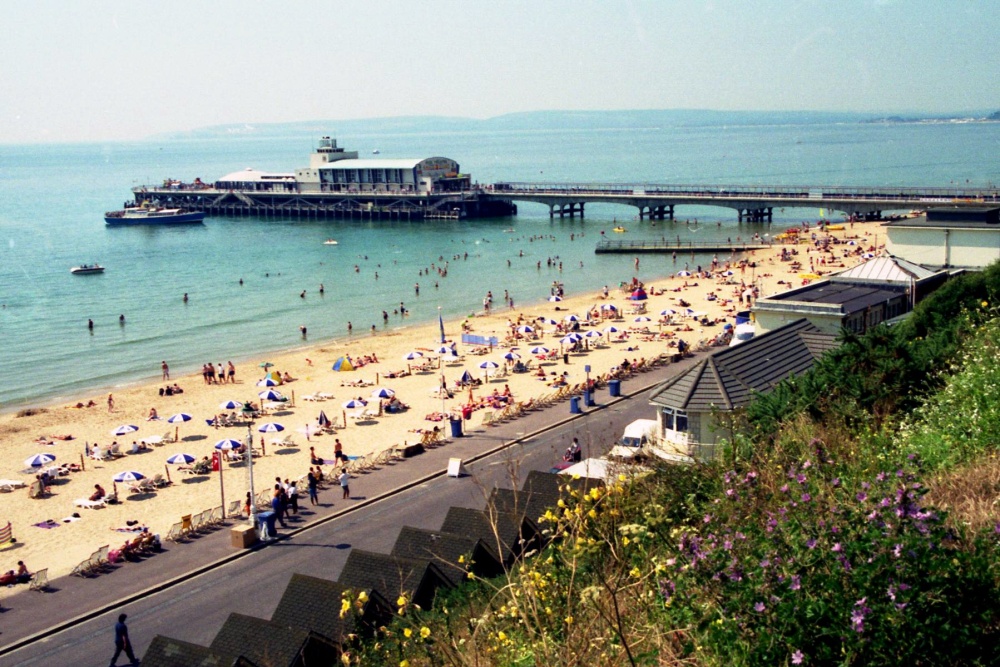
Bournemouth Pier and beach. Dorset - Image by PicturesOfEngland.com member P. G. Wright (view gallery)
Bournemouth has been a place of international acclaim since Edward VII brought his mistress Lillie Langtry here in 19th and 20th-centuries. The other major event in the making of the resort was the railway which reached here in 1890, hither-there-to, the town was mainly residential.
Seven miles of glorious golden sands, fringed by the bluest of seas lapping the shore, make Bournemouth a firm favourite for family holidays. The beach is backed by wide promenades, and tree-clad cliffs which are descended by zigzag paths. It is an attractive town, made more beautiful by huge floral displays and wonderful sub-tropical plants whose year round growth is encouraged by Bournemouth's mild climate. In summer, the town has an average of 7.7 hours of daily sunshine, thus it compares favourably with other European resorts, and draws sun-worshippers from all over England and beyond. It is also an idyllic place for enthusiastic builders of sand castles, the resort prides itself on how well it caters for children and is especially proud of its pioneering KidZone scheme. During the holiday season Bournemouth hosts a Summer Festival for Families, running for six weeks, the festival has activities and attractions to suit children of all ages and abilities. There is a Kids Free Entertainment tent, and beach GameZones offers a programme crammed with activities ensuring fun-filled days for every child. With a new Wacky Warehouse as well, children visiting Bournemouth are spoilt for choice! The festival offers plenty for adults to enjoy and admire. Friday opens up the weekend with a spectacular fire-work display and Flowers by candlelight makes a wonderland of the lower gardens that simply leaves you breathless at such a stunning transformation. The wonders of the deep are on display at Oceanarium and for some this is a safer bet than deep sea fishing! The festival caters for music lovers, groups from all over the world perform at Bournemouth's Music Makers festival where all musical tastes are provided for.
The town is fortunate to have retained its sedate air of exclusiveness. By day, its shops offer a fascinating display of merchandise which ranges from designer clothing, costly paintings and antiques to sea-side souvenirs. Whatever you want, you are sure to find it here. The fashionable new shopping square blends well with old Bournemouth, its mosaics and outstanding camera Obscura centrepiece, gives an atmosphere of chic usually reserved for continental towns. When night falls, another transformation takes place and Bournemouth throbs to the music of the night in theatres, night-clubs and pubs. Hotels too, offer dinner dances and cabaret style entertainment.
The splendid gardens and cliffs make a superb back-drop for the many international sea-sport events held throughout the summer of which the UKOBA Powerboating Grand Prix and Beach volleyball Grand Prix are just two. Sailing is popular, with the sea often looking as though it is a forest of colourful sails. Fishing trips and day trips to view the natural beauty of the coastline from the comfort of a boat can be arranged.
This is the home of the world famous Bournemouth Symphony Orchestra, so visitors are assured of a rich diversity of cultural experiences, these include ample museums and heritage centres telling of the historical and cultural advancement of the town. The Russell Cotes Art Gallery and Museum shows a range of works of art that should not be missed.
Sadly, one of Bournemouth's most magical venues, scene of entertainment, tea-dances and glittering occasions is no more. The famous Winter Garden Theatre and Ballroom which opened its doors in 1875 is no longer. The opening of the Bournemouth International Centre finally brought about its demise but the new centre with its exceptional acoustics makes an attractive venue for many world famous stars, who always play to a packed house.
With so much to offer and given its wonderful south coast location bordered by the harbours of Christchurch and Poole, and the close proximity of the Isle of Wight and New Forest, it is not surprising to find Bournemouth is now one of England's premier tourist destinations - you should come, bring the family, you will not be disappointed.
ID#260
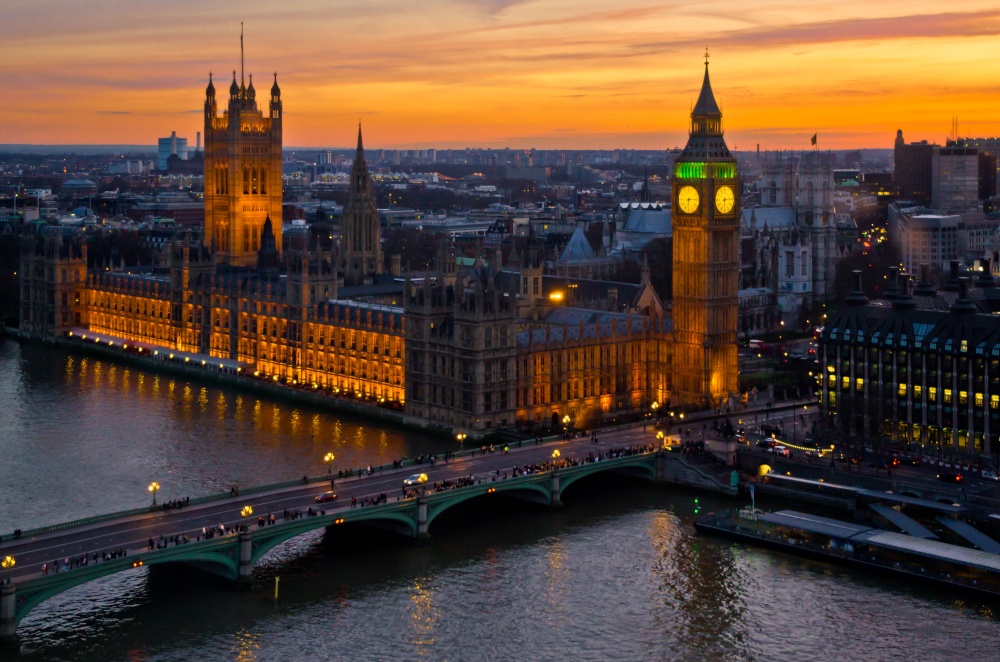
Houses of Parliament, London - Image by PicturesOfEngland.com member Atanas Tomov (view gallery)
London is one of the top cities in the world, full of history and so many beautiful and fascinating places to visit.You will never tire of all the many fascinating and exciting things to see and do. You can spend a lifetime in London and do or see something new every day!
London is one of the World's most exciting, cultural destinations where visitors can walk with history whilst enjoying all that is best of modern day facilities, shops, theaters and restaurants.
This is a city of contrasts where you can witness Pomp and Circumstance as the King glides through the gates of Buckingham Palace in the splendid Irish state coach to follow the grand processional route of the Mall, Horse-guards Arch, and on into Whitehall for the state opening of Parliament. Or you can wander among the green lung's of London's Royal Park's, which centuries ago were the former hunting ground of Monarchs. These themselves attract over 30 million tourists each year, they start with St.James's Park and lead past the palace to join with Green Park, Hyde Park and Kensington Gardens. The deer and horses have long since gone, giving way to lush flower and water-filled expanses of tranquility where weary office workers and travelers can rest.
London is a sprawling conurbation combining two cities, each with distinctly different beginnings, and separate roles, characters and styles. The City of London is the crowded center of Britain's trade and finance; Westminster is the home of Court, government, high society, churches, and houses full of treasure. Linking both is the River Thames, England's greatest water thoroughfare, which has played a continuous role in the building of the city, borne silent witness to so much history and is the reason why the capital is where it is.
By day visitors can shop in a metropolis offering a huge mix of retail outlets ranging from Harrods to Asprey's, Designer Boutiques to Marks and Spencer, fruit shops, multi-cultural delicatessens, chocolate shops and food from just about every country in the world!
Visitors can take in any one of a number of lively markets, many of which began in medieval times. London is justifiably proud of its markets, each is unique, with its own character, flavor and specialisation - such as Columbia Road Flower Market open every Sunday morning. This is somewhat off the beaten track but is worth the effort it takes to get there - for late risers there are plenty of places to have brunch! Others include the world renowned Covent Garden, Camden, Greenwich, Portobello Road, Petticoat Lane and Bermondsey Antique Market-certainly the place to go to grab a bargain. Travelling around is easy, you simply hail any one of the thousands of famous Black Cabs, or board a bright red double-decker bus. The under-ground offers a network of tubes, ideal for getting quickly from one area to another. (Look for a map on our maps section)
If it is the cultural experience you want, then after seeing London's great architectural gems, you can take you choice of over 200 museums and art galleries, or visit Madame Tussaud's, Kew Gardens, and the Royal Courts of Justice. London has some of the finest theatrical venues in the world, with a theatre-land unsurpassed by any other country. Theatre's range from the Drury Lane Theatre dating from 1812 to the Barbican which opened its doors in 1982, included too is Nash's famous Haymarket Theater of 1821. In all London offers 40 theaters showing plays, musicals, ballet and opera, leaving visitors completely spoilt for choice. There are many ticket agencies offering discount tickets, especially at short notice - ideal if your just visiting.
After-noon tea is a quintessential English tradition that no visitor to London should miss. One of life's "must do's" is to drop in to either Brown's Hotel or the Ritz to enjoy after-noon tea served in the most elegant of English surroundings. Another unforgettable experience is to view London from the dizzy heights of the London Eye, on a clear day the vista can stretch as far as Heathrow Airport and Windsor Castle. Sporting enthusiasts have Wimbledon, Wembley, and even a golf course or two can be found within easy reach of the city centre.
London by night is an amazing experience, pubs on every corner, great buildings and bridges lit up against the night-time sky, add this to numerous clubs and restaurants serving cuisines of more than 70 countries, and this will leave you in no doubt that London has a cafe society second to none, beating that to be found in any other European capital.
In London the romance of the past is everywhere but it blends very well with the present. It is a cherished place where you are overwhelmed by its sheer scale, and yet pleasantly surprised by the warmth of its welcome. A century ago London was the largest and gayest capital city in the world, today it remains a vibrant multi-cultural city of romance that is the most historic and remarkable capital in all of Europe.
ID#54
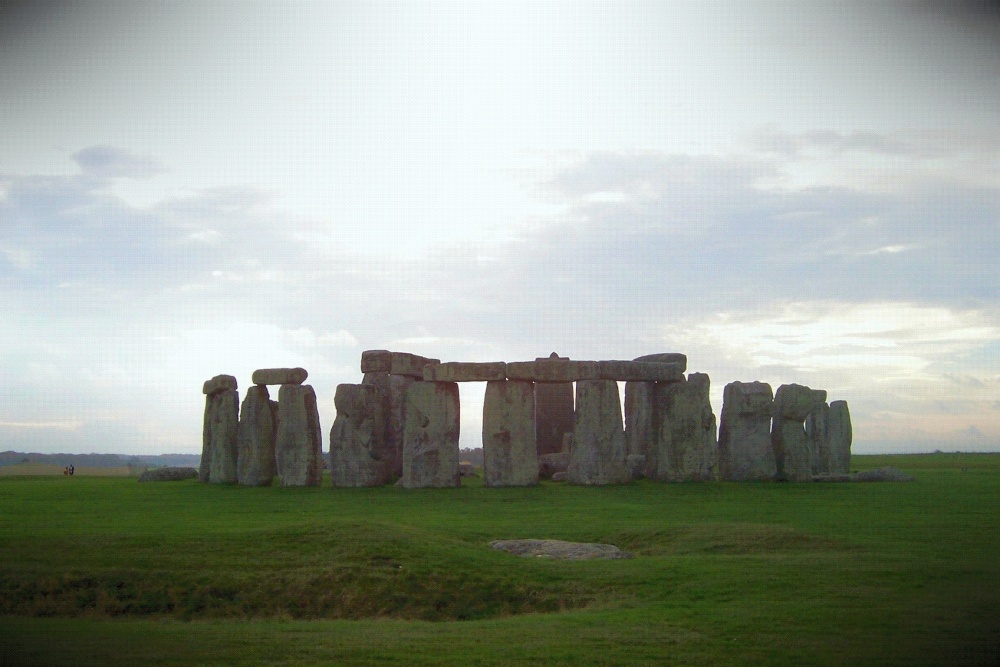
Stonehenge, looking West - Image by PicturesOfEngland.com member Ruth Gregory (view gallery)
Stonehenge is one of the most famous prehistoric monuments in the world and one of England's most iconic landmarks, consisting of a ring of large standing stones that reach 13 feet high and weigh in at around 25 tonnes.
It is believed to have been constructed between 3000 BC and 2000 BC, with the surrounding circular eathworks dating back to around 3100 BC. Stonehenge is a UNESCO World Heritage Site, managed by English Heritage and owned by the Crown.
Its purpose has been the topic of much debate, with theories ranging from a druid temple, to that of a solar calendar for ancient astronomers, but strong evidence now suggests that it was used as some sort of burial site and ceremonial complex, after hundreds of human bones were discovered at the site.
ID#155
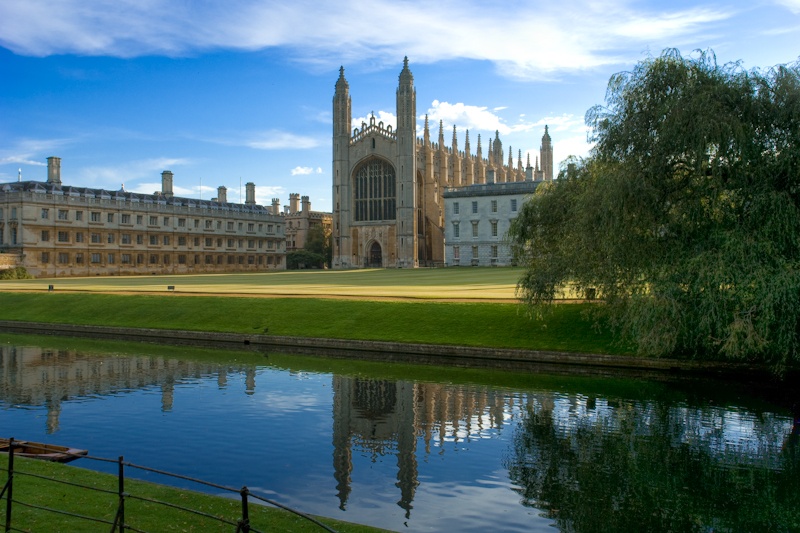
King's College Chapel - Image by PicturesOfEngland.com member Andrew Sharpe (view gallery)
Cambridge has an abundance of magnificent buildings, and these together with riverside walks, wonderful museums and quaint old streets, quickly draw the visitor under the spell of this historic and charming City.
The heart of this ancient City is dominated by the great University buildings. King's college is known for its chapel, a medieval masterpiece that was built long before the rest of the college. Of the other buildings, the oldest Peterhouse - the first college founded in 1284 belongs to Clare college, part of which was once occupied by a 12th-century Nunnery. Trinity college, established in 1546 by Henry V111 and now the largest college. Trinity has a spectacular Library, designed by Sir Christopher Wren, and Trinity's chapel contains memorials to famous past students including Isaac Newton and Lord Tennyson.
The many students give the city a lively vibe. There is always something going on with much to see and do.
There are many interesting places to visit in this famous City, one being the American cemetary and chapel. The War Memorial Chapel, in stark contrast with Cambridge's historic buildings, is a striking example of modern architecture. Inside, is a 540-square foot map showing the Atlantic air and sea routes used by American forces during the second world war. Not surprisingly, this unique place is included in the tour itinery of our many American friends.
The City centre provides a host of interesting shops and restaurants, while in and around Cambridge you will find several hospitable public houses and inns, all offering tasty food in a relaxing and cosy atmosphere.
Other noted places to visit - Buckden Palace, Bourn Post-Mill and Trumpington.
ID#38

| Article Title | Author | Date |
| Stonehenge | David Coe | 23rd January 2024 |
| Derwent Dam: A Historic Icon in the Heart of Derbyshire | David Coe | 14th January 2024 |
| The Native Trees of England: A Botanical Tapestry | David Coe | 15th December 2023 |
| Stoke-on-Trent: The Potteries Hub | David Coe | 12th December 2023 |
| England's 'Heritage at Risk Register' 2023 | David Coe | 11th December 2023 |
| 10 of the prettiest villages in the Lake District, Cumbria | poe | 16th March 2023 |
| Where to see Daffodil Displays in the South West of England | poe | 3rd March 2023 |
| 10 Famous Landmarks in Dorset | poe | 1st March 2023 |
| List of popular Dorset market towns including market day | poe | 1st March 2023 |
| 10 Best Historic Attractions to visit in York, England | poe | 16th May 2022 |